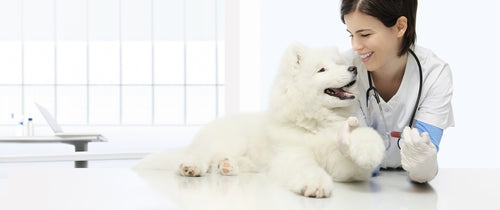How Often Should I Go To The Vet?
Tuesday, May 15, 2018 03:23:01 PM America/Los_Angeles
Veterinary health is essential for a pets’ health and well being. While most people think that taking your dog to the vet once a year is enough, it might not be. Veterinary treatment for your dog should begin from the time the pup is born. However, the frequency of the treatment depends on the dog’s age and their general health. For example, a young puppy requires more medical attention than a healthy six-year-old dog. A six-year-old puppy will be fine with just one annual checkup.
If you are worried about the healthcare costs, remember preventative health care keeps your pet healthier for longer, and it will save you money in the long run. You can also get pet insurance that will assist you to pay some of the medical bills.
Continue reading to learn a little more about your pet’s health and well being.

visivastudio via shutterstock
Puppies one year and below
At this age, your pet just like a small child requires regular visits to the pet. Experts recommend taking your puppy for a wellness exam at least once every month until they are 16 weeks old for routine vaccine schedule. The vaccination schedule for the puppies.
• 6 - 8 weeks the puppy gets their first DHLPPC shot
• 10 – 12 weeks they get their second DHLPPC shot
• 12 – 24 weeks they get their rabies shot
• 14 – 16 weeks they get their third DHLPPC shot
Its important to note that during this time, until your dog has ad all of their vaccinations, it is dangerous for them to be outside. If they are exposed to other dog's urine they are likely to contract diseases since they are not fully vaccinated. Your dog will need an indoor dog potty solution, such as DoggieLawn, that they can use indoors or on your patio as a patio pet bathroom.
While the above is a vaccination schedule for the puppy, it is important to note that the schedule can vary depending on your location and the health of your puppy. It is important to work hand in hand with your vet to establish the appropriate course for your puppy.
During the wellness visits, the vet will examine the puppy to determine if he is developing well and that he is healthy. After the puppy gets their vaccination shots, you will return the puppy when they turn six months for them to be spayed or neutered. Taking your puppy for the vaccination is an investment to protect the puppy from dangerous diseases.
One to seven years – Adulthood
At this stage of life, your dog is probably the healthiest he will ever be especially if they had all their vaccination shots. At this stage, your dog will need an annual wellness exam. The annual wellness exam will help you track the growth and development of your dog. It also offers you a chance to discuss matters with your vet such as indoor potty training for your dog. Take advantage and get your vet’s thoughts on housebreaking, wee wee pads, and even dog bathrooms. Think of the checkup as preventative care.
During the annual checkup, the vet will give the dog a full checkup including the heart, lungs, ears, and eyes. He will also check for flees and other afflictions. During this visit, the vet will suggest your dog’s nutrition, dog care and make any recommendations for activities and medication depending on the dog’s health status.
Eight years and above – senior years
Smaller dog breeds reach their geriatric age at eight years while larger dog breeds can be considered seniors at six years. Senior dogs have more health needs and are usually more prone to illness and other age-related injuries, and that is why they should be taken to the vet at least once every six months. Other than the regular checkups, your vet might recommend several diagnostic tests such as fecal tests and blood tests. He will also recommend ultrasounds, blood pressure test, and chest radiographs. These diagnostic tests will help the vet assess the health of your dog. The results of the diagnostic tests will be of assistance in case your dog falls ill. The vet will look back on the tests to see what normal looks like.
As your dog starts to age, you will notice that he starts to slow down because he might develop arthritis or other degenerative diseases. He will also start having dental problems. It is therefore important that you take him to the vet so he can catch the problems early and offer a solution. Your vet might also suggest changing your dog’s diet because elderly dogs have different nutritional needs and they are less active. Since your pet is not as active as he was, he might start gaining weight. Obese dogs have a lower lifespan, and you do not want that for your dog. Your vet will educate you on how to exercise your dog and give him a balanced diet.
Emergency cases and ailments.
In an ideal situation, the annual and semiannual visits are enough for your dog to get the medical attention they need. However, there are some emergency cases where you need to take the dog to the vet immediately. It is important that you look for some signs and symptoms that show you should take the dog to the emergency room. These symptoms include;
• He is unconscious, and won't wake up
• He has ingested a toxic substance
• There are signs of extreme pain like shaking and whining
• He is having a seizure
• He has problems breathing
• Brocken bones among others
Remember to follow your instincts because nobody knows your dog better than you do. It is important that you find a vet that offers 24-hour care. In case you are worried about your dog’s behavior, always call your vet and do not shy away from calling too often.
What matters is that your dog lives his best healthy life. To prolong the life of your dog, it is advisable to take him to the vet for regular checkups.

